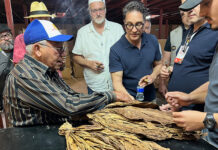The book then covers all of the processes involved with growing and making cigars, cigar anatomy, vitolas, and even pipes and pipe tobaccos. Interestingly, our content on pipes and pipe tobaccos incites most of the complaints I hear from readers and students. One faction complains that there is too much pipe and tobacco content—because they don’t sell or smoke them—and the other complains that there is not enough! While pipes and pipe tobaccos constitute a very small percentage of the luxury tobacco industry, we have always maintained the philosophy that in order to be a tobacconist you must understand the entire profession, industry and its products. In addition, pipes and tobaccos are important to the retail tobacconist profession. If you are in business long enough, you will start to search out ways to grow your revenue and customer base, and this is the most logical way to do it. Furthermore, many pipe smokers eventually gravitate to cigars and vice versa, so there is a natural synergy.
The middle of the book is composed of how-to and FAQ-type content—everything an expert tobacconist and passionate consumer would want to know. Much of this content is timeless, like cigar lighting, cutting, smoking issues, cigar storage and so on, and then the book transitions into humidor etiquette and cigar myths—great content inspired by and created for tobacconists and consumers. While things like not touching the head of a cigar that you don’t own, smoking in a humidor, purchasing from the store you are smoking in and not licking a cigar before you use someone else’s cutter may seem like common sense, they are not! These sections add a lot of value and round out a very thorough and comprehensive education.
The last chapter of The Tobacconist Handbook is our Tasting School. Here we establish science, facts, terms and methods that will help consumers enhance their appreciation of luxury tobacco products as they progress on their own journey. Finally, the book ends with our massive glossary.
I think some of the most important facets of the book and our educational focus are the things you don’t see and the content we choose to omit. TU teaches fundamentals and gives tobacconists a strong foundation, but we do not tell people how to run their businesses or what to think. Tobacconists are strong-willed individualists, and all of them run their businesses differently, so we always have to be careful not to pontificate to them or tell them what they “should” do. Yes, we teach history and context, but we have to draw a clear distinction between what we have a right to teach professionals and what we don’t.
Similarly, taste is subjective, and we spend a lot of time repeating that. We don’t tell you what’s good or bad or what you should or shouldn’t like. It is important for us to help define words like “body,” “strength” and “spice,” but we can’t tell you how to measure or interpret those sensations and feelings.
What part of the book do you think will be the absolute must-read chapter for most? I think new tobacconists and people just getting into luxury tobacco should read the book from front to back. After they establish their fundamental knowledge, the book is a great resource to refresh with. The glossary and FAQ [section] are also a great go-to when you need to look something up. But there is also value in going back and remembering things [you] forgot or revisiting topics as [you] grow and evolve. I recently experienced a rediscovered passion for air-curing after refreshing myself on that content. I think time changes us, and sometimes we can get reinspired when we go back and see things from a newer perspective. So, I think the answer to that question changes over time as we grow, but the facts and perspective in the book should be timeless and always have something to offer you.
There’s a lot of technology involved in being a tobacco retailer today. Does the book include anything about the best technology or current digital practices for tobacconists? That’s such an interesting question because I am not sure that is in our wheelhouse of expertise. We have content on marketing and promotional strategies in our Service College, and TU uses all of the major social media platforms and technologies to communicate. There are also business magazines and organizations that put out content about using technology and digital practices. Sometimes that content is very generic and other times it is very specific. I know that in my retail businesses we try many strategies and end up doing what works for us. Social media and digital strategies can be very personal to a business, and not every idea works for every company. Ultimately, every business has its own personality, and their strategies have to be personally tailored to them.
With that said, the book is an old-fashioned product, so we mostly keep our focus on timeless and fundamental topics. The one major deviation would be the section on Certified Cigar Reviews. Our newly emerging Certified Cigar Reviews (CCR) website is an extension of our Tasting School and Tasting Methodology, so it was natural to include the CCR content, but a book cannot fully explain a website and process that must be experienced. Ultimately, there is a time and a place for everything, and many of the digital tools and value we create simply did not fit into the book.
How closely is the book tied into Tobacconist University’s various certification programs? The Tobacconist Handbook is a distillation of our online academic curriculum, and you should be able to pass any of our certification exams with a 90 percent score if you study the book. There are, of course, many multimedia enhancements in our online curriculum, but the exams cover fundamental knowledge, which the book delivers. The updated book also includes a section on cigar pairing, which is derived from our Certified Cigar Sommelier Tobacconist (CCST) school, so we are making every effort to keep the book up to date with our online certifications. With that said, there are limitations to the book because a book is a book is a book! For example, our online Cigars 101 course includes more than four hours of video, and a book will never be able to replicate that kind of education—just like reading about cigar smoking can never come close to the experience of actually smoking [a cigar].
Do any of the profits made from sales of The Tobacconist Handbook benefit your ongoing efforts with Tobacconist University? Sure. Most of what TU provides is free to consumers and tobacconists but not free to create, host and maintain, so every penny we make is vital to our existence. In fact, until 2020 my retail businesses were the major funding source for TU. We are just now becoming self-sufficient. While we created Certified Cigar Reviews as a free service for our certified tobacconists, we will try to sell a low-cost version to others. In 2020 we released a Cigars 101 class for consumers, and all of this helps support everything else we do. While I don’t think The Tobacconist Handbook will generate a great deal of money, it does help promote all of our other products and services, and all of that goes back to reinforcing our mission: to help preserve the luxury tobacco industry for generations to come while supporting retail tobacconists.
The Tobacconist Handbook by Jorge Armenteros is available wherever books are sold. Wholesale orders can be placed directly with the book’s publisher by emailing bbellemore@skyhorsepublishing.com. Signed copies will also be available in Tobacconist University’s campus store sometime in 2021.
This story first appeared in the January/February 2021 issue of Tobacco Business magazine. Members of the tobacco industry are eligible for a complimentary subscription to our magazine. Click here for details.







